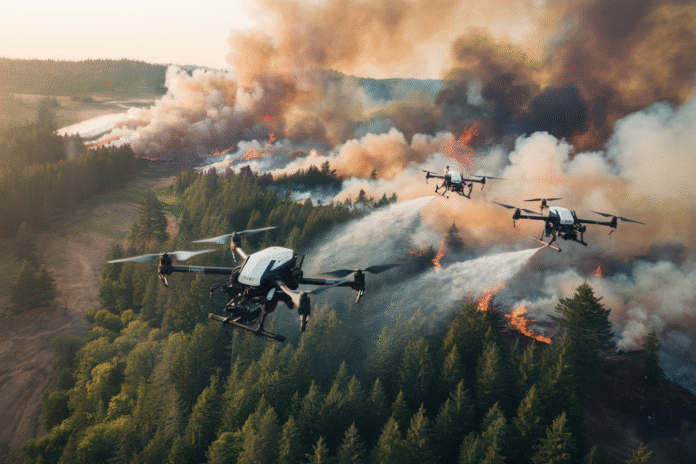The battle against wildfires has reached a critical juncture, with states like Oregon seeking innovative solutions to combat this escalating threat. “The future we were promised is here,” reflects a growing sentiment among environmental advocates, as advanced technologies emerge to address pressing challenges. With wildfires becoming increasingly devastating, the need for effective firefighting methods has never been more urgent. Oregon’s recent agreement to explore the potential use of Yamaha’s Fazer Sar helicopter drones marks a significant step forward in this endeavor. This initiative not only highlights the urgency of the situation but also poses the question: can technology truly reshape our approach to wildfire management?
The stakes are high as the frequency and intensity of wildfires continue to rise, threatening lives, ecosystems, and property across the nation. Traditional firefighting methods often struggle to keep pace with the rapid spread of flames, leading to catastrophic consequences. By embracing drone technology, Oregon aims to enhance its firefighting capabilities, potentially revolutionizing the way wildfires are fought. The implications of this agreement extend beyond state borders, as other regions grappling with similar challenges may look to Oregon’s pioneering efforts as a model for their own wildfire management strategies.
Innovative Technology in Wildfire Management
As wildfires become more frequent due to climate change, innovative approaches are essential for effective management. The use of drones, particularly Yamaha’s Fazer Sar helicopter drones, represents a significant advancement in firefighting technology. These drones are designed to provide aerial support, allowing for real-time surveillance and targeted water or fire retardant deployment. This technology offers a level of precision and efficiency that traditional methods often lack.
For instance, the Fazer Sar can access hard-to-reach areas, providing vital information to ground crews while minimizing risk to human life. The drone’s ability to operate in hazardous conditions enhances situational awareness, enabling firefighters to make informed decisions quickly. This capability is particularly crucial in the early stages of a wildfire when rapid response can significantly alter the outcome. By integrating this technology, Oregon seeks to not only improve its immediate response to wildfires but also set a precedent for future firefighting efforts across the country.
The potential of drone technology in firefighting is vast, with implications that extend beyond mere efficiency. As more states consider adopting similar technologies, the focus will shift toward developing comprehensive strategies that incorporate drones into existing firefighting frameworks. This evolution could lead to a more coordinated and effective response to wildfires, ultimately saving lives and protecting communities.
The Economic Implications of Drone Usage
The financial ramifications of utilizing drone technology in wildfire management are significant. Traditional firefighting methods often incur substantial costs, including personnel, equipment, and logistical expenses. By integrating drones into their operations, states like Oregon can potentially reduce these costs while enhancing their effectiveness. The initial investment in drone technology may be offset by the long-term savings achieved through improved efficiency and reduced damage from wildfires.
Moreover, the use of drones could lead to a decrease in insurance claims related to wildfire damage, as faster and more effective responses mitigate the extent of destruction. This shift could have broader economic implications, influencing property values and community resilience in fire-prone areas. As Oregon pioneers this approach, other states may follow suit, creating a ripple effect that could transform the economic landscape of wildfire management.
The exploration of drone technology also opens up opportunities for job creation within the tech and environmental sectors. As demand for skilled operators and maintenance personnel increases, local economies may benefit from the growth of this emerging industry. The collaboration between government agencies and technology companies could foster innovation and drive economic development, making the adoption of drones a win-win situation for both public safety and local economies.
Challenges and Considerations in Implementation
While the potential benefits of using drones in wildfire management are substantial, several challenges must be addressed before widespread implementation can occur. Regulatory hurdles pose a significant barrier, as the integration of drones into airspace must comply with federal and state aviation regulations. Ensuring that drone operations do not interfere with manned aircraft and that they adhere to safety protocols is paramount.
Additionally, the effectiveness of drone technology in diverse wildfire scenarios remains to be fully tested. Factors such as varying terrain, weather conditions, and the scale of wildfires can impact the performance of drones. Comprehensive testing and data collection will be essential to refine operational protocols and maximize the effectiveness of drone deployment in real-world situations.
Furthermore, public acceptance of drone technology in firefighting is crucial. Communities must be informed about the benefits and limitations of using drones, as well as the measures in place to ensure safety and privacy. Building trust and transparency will be essential in garnering support for this innovative approach to wildfire management.
The Future of Wildfire Management in Oregon and Beyond
Oregon’s exploration of Yamaha’s Fazer Sar helicopter drones represents a pivotal moment in the fight against wildfires. As the state moves forward with this initiative, it sets the stage for a potential transformation in how wildfires are managed across the United States. The integration of advanced technology into firefighting strategies not only enhances operational efficiency but also aligns with the growing need for innovative solutions to address climate-related challenges.
As other states observe Oregon’s efforts, a collaborative approach to wildfire management may emerge, fostering knowledge sharing and innovation across regional boundaries. This could lead to a unified national strategy that leverages technology to protect communities and ecosystems from the devastating impacts of wildfires.
Ultimately, the successful implementation of drone technology could usher in a new era of wildfire management, where technology and traditional methods work in harmony to combat an increasingly urgent threat. As Oregon takes the lead, the future of firefighting may very well be shaped by the advancements in drone technology, offering hope for more effective responses to wildfires in the years to come.


